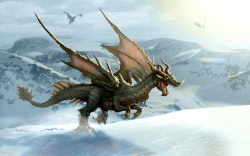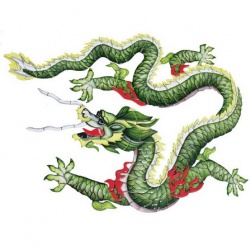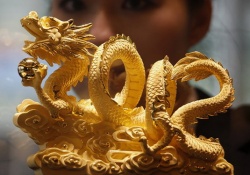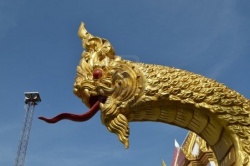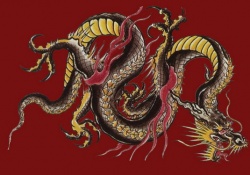The Dragon, Buddhist Mythical Creature
Unlike its demonic Western counterpart, the Asian dragon is an auspicious creature of great creative power. The earliest written description of the Chinese dragon occurs in the I Ching or "Book of Changes" where it appears as a symbol of the strong light giving male yang principle of heaven, spring, change and creative energy. The dragon possesses the elusive or hidden nature, with the ability to transmute its form at will. It can render itself invisible, diminish to the size of a silkworm or expand its body to fill the heavens. At the spring equinox it ascends into the sky, where it remains until the autumn equinox when it descends into a deep pool, encasing itself into the mud until the next spring. As a symbol of heaven and the light giving powers of spring, the dragon is equated with the east, the color blue and the number nine of the strong yang principle. In Chinese art the young azure dragon is often depicted with his earthly yin counterpart, the old white tiger.
The head of the water dragon bears a strong resemblance to the Indian makara. The typical dragon is said to possess three sections and nine likenesses.
The three sections are: its head to forelegs, forelegs to waist and waist to tail.
The nine likenesses are:
(1) it has a head like a camel;
(2) horns like a deer;
(3) eyes like a demon;
(4) a neck like a snake;
(5) scales like a fish;
(6) a belly like a frog or a giant clam;
(7) ears like a cow;
(8) forelegs and paws like a tiger;
(9) talons like an eagle.
Along its back is a ridge of flame-like dorsal scales, and pointed dorsal plates sprout from its jaw, chin, knees and tail. Carp-like whiskers extend from the dragon's upper lip and its coiled and flowing hair resembles a horse's mane. Its two eyes are wild and staring and its eyebrows blaze upwards. Its teeth are sharp and its tong long and twisting. Lighting like flames emanate from the dragon's upper legs as it writhes in a billow of clouds with its foot or feet clutching a precious or four precious gems.
The head of the water dragon bears a strong resemblance to the Indian makara. The typical dragon is said to possess three sections and nine likenesses. The three sections are: its head to forelegs, forelegs to waist and waist to tail.
The nine likenesses are:
(1) it has a head like a camel;
(2) horns like a deer;
(3) eyes like a demon;
(4) a neck like a snake;
(5) scales like a fish;
(6) a belly like a frog or a giant clam;
(7) ears like a cow;
(8) forelegs and paws like a tiger;
(9) talons like an eagle.
Along its back is a ridge of flame-like dorsal scales, and pointed dorsal plates sprout from its jaw, chin, knees and tail. Carp-like whiskers extend from the dragon's upper lip and its coiled and flowing hair resembles a horse's mane. Its two eyes are wild and staring and its eyebrows blaze upwards. Its teeth are sharp and its tong long and twisting. Lighting like flames emanate from the dragon's upper legs as it writhes in a billow of clouds with its foot or feet clutching a precious or four precious gems.
Like the Indian naga, the legendary Chinese dragon has a strong affinity with weather control, particularly with billowing thunderclouds and electric storms. Forked lightning emanates from the dragon's claws and fiery ball-lightning blazes from its mouth. Its roar is the roll of thunder, its restless writhing amidst the dark storm clouds creates sheet lightning and the downpour from its glistening scales falls as torrential rain. The jewel(s) that the dragons grasps in its claw produce dew and when it clenches its claws tightly it produces a downpour of rain. Jade dragons were carved and images of dragons painted by famous artists to alleviate droughts in imperial China. Waterspouts, tidal waves, and submarine earthquakes were all viewed as manifestations of the four great dragons of the ocean.
In Buddhism the dragon is the vehicle of Vairocana, the white Buddha of the east or center. The azure or turquoise dragon is the vehicle of many Buddhist protector deities, aquatic or storm gods and guardians of treasure. As a treasure guardian the Sino-Tibetan dragon may be closely identified with the Indian naga.
The Tibetan term for dragon, druk (Tib. 'brug), refers to the sound of thunder. The Buddhist Kingdom of Bhutan is known as Druk Yul which means "the land of the thunder dragon". Bhutan's inhabitants are commonly known as drukpas, and named after Drugpa Kagyu lineage of Tibet. This lineage was established by Tsangpa Gyare (1126-1211), who is said to have witnessed nine dragons ascending into the sky near Gyantse in central Tibet and later established his monastery of Ralung at this isolated site. In Tibetan Buddhism the ascent of a group of dragons is always a most auspicious omen.
